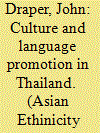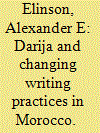|
|
|
Sort Order |
|
|
|
Items / Page
|
|
|
|
|
|
|
| Srl | Item |
| 1 |
ID:
137224


|
|
|
|
|
| Summary/Abstract |
This article examines the introduction of multilingual Thai/Thai Lao/English signage in commercial areas of the Faculty of Humanities and Social Sciences at Khon Kaen University, the principal tertiary university for the 19 million citizens of Northeast Thailand, the majority of whom are of the minority ‘Thai Lao’ ethnicity, an ideological construction that is presented in some detail. This introduction of signage followed a previous study to introduce officially sanctioned multilingual direction-giving signage, including the main faculty sign, in three prominent areas of the Faculty. The survey employed a complex methodology to survey the opinions of 300 students together with observation of students and interviews with members of the faculty. The research type is therefore a mixed-methodology investigation of identity and language policy planning, cultural promotion, glocalization, Gal and Irvine’s semiotic ideology structuration process, the (urban) linguistic landscape and Bourdieu’s theories of social reality. The study found high levels of support for the signage from the student body, members of the faculty and the stallholders themselves.
|
|
|
|
|
|
|
|
|
|
|
|
|
|
|
|
| 2 |
ID:
124478


|
|
|
|
|
| Publication |
2013.
|
| Summary/Abstract |
Social, political, and technological changes have forced changes in the contemporary Moroccan linguistic landscape. In print media, advertising, music, fictional writing, and translation, Moroccan Arabic (d?rija) is being written in a variety of ways that point to a shift in perceptions and usage of d?rija in daily Moroccan life. In this article, I provide a discussion of recent developments in the use of d?rija in writing, and discuss how this evolving situation is articulated by intellectuals, journalists, publishers, fiction writers, and translators.
|
|
|
|
|
|
|
|
|
|
|
|
|
|
|
|
|
|
|
|
|